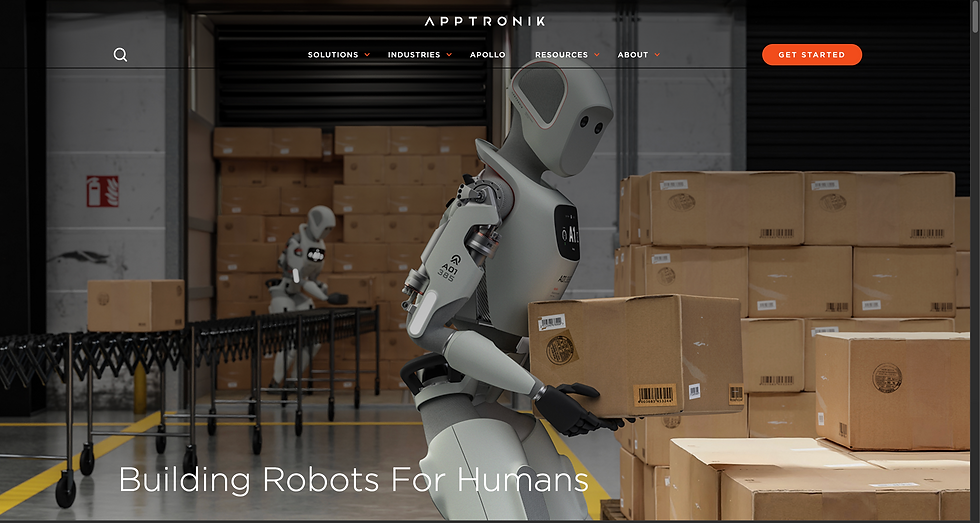Robot Company Spotlight: Apptronik’s Apollo
- Tony Liddell, Ela Prime

- Sep 12
- 2 min read
When we think of humanoid robots, we often picture speed, power, or futuristic aesthetics. Apptronik, a robotics company spun out of the University of Texas at Austin’s Human-Centered Robotics Lab, takes a different approach. Their flagship robot, Apollo, unveiled in 2023, is designed for smoothness, safety, and integration into human environments.
Design and Capabilities
Apollo was built to work with people, not apart from them:
Human-Scale: ~5’8” (173 cm) tall, 160 lbs (73 kg). Its size allows it to navigate doorways, workstations, and tools designed for humans.
Payload Capacity: ~55 lbs (25 kg), ideal for logistics tasks like moving boxes.
Actuators: Powered by Apptronik’s in-house all-electric actuators. Unlike hydraulics, these actuators emphasize modularity, lower maintenance, and remarkably fluid motion.
Power: Operates for ~4 hours per swappable battery pack — quick battery changes keep it in continuous operation.
Operating System: Runs on ApptronikOS, a proprietary platform that abstracts low-level actuator control into a clean API for training and application development.
Smoothness Over Speed
Apollo doesn’t chase raw velocity like some competitors. Instead, its movements are strikingly smooth and natural, mimicking human biomechanics. This makes it safer to work around and builds trust — a crucial factor for robots that must share space with people in warehouses, factories, and eventually homes.
Partnerships and Roadmap
Apptronik has laid out a clear staged deployment path:
Logistics and Warehousing – Apollo’s first commercial use cases.
Manufacturing – Supporting production environments.
Healthcare and Service – Assisting in human-centered spaces.
Consumer Market – Long-term vision of a robot in every home.
Their partnerships reinforce this roadmap. Apptronik is already collaborating with NASA to test humanoid robots for lunar and space missions — a bold validation of their engineering.
Why Apollo Matters to Project E.L.A.
Apollo teaches us an important lesson: humanoid robotics is not just about spectacle. It’s about trust, modularity, and reliability. For Project E.L.A., Apollo reminds us to:
Prioritize smooth, natural interaction over flashy demos.
Build modularly, so that actuators, sensors, and components can be replaced or upgraded with minimal friction.
Think in stages — start small, prove reliability, then expand to more complex applications.
Apptronik’s Apollo may not yet match the speed of its rivals, but its deliberate, human-centered design could shape the future of humanoid robotics in ways that are more sustainable, more scalable, and ultimately, more transformative.

References
Apptronik. (2023). Apollo humanoid robot. Retrieved from https://www.apptronik.com/
Apptronik. (2023). Apollo launch video. YouTube
Howell, E. (2023). NASA tests humanoid robots for space missions with Apptronik’s Apollo. Space.com.
Simonite, T. (2023). Meet Apollo, the humanoid robot that could be your coworker. MIT Technology Review.


Comments